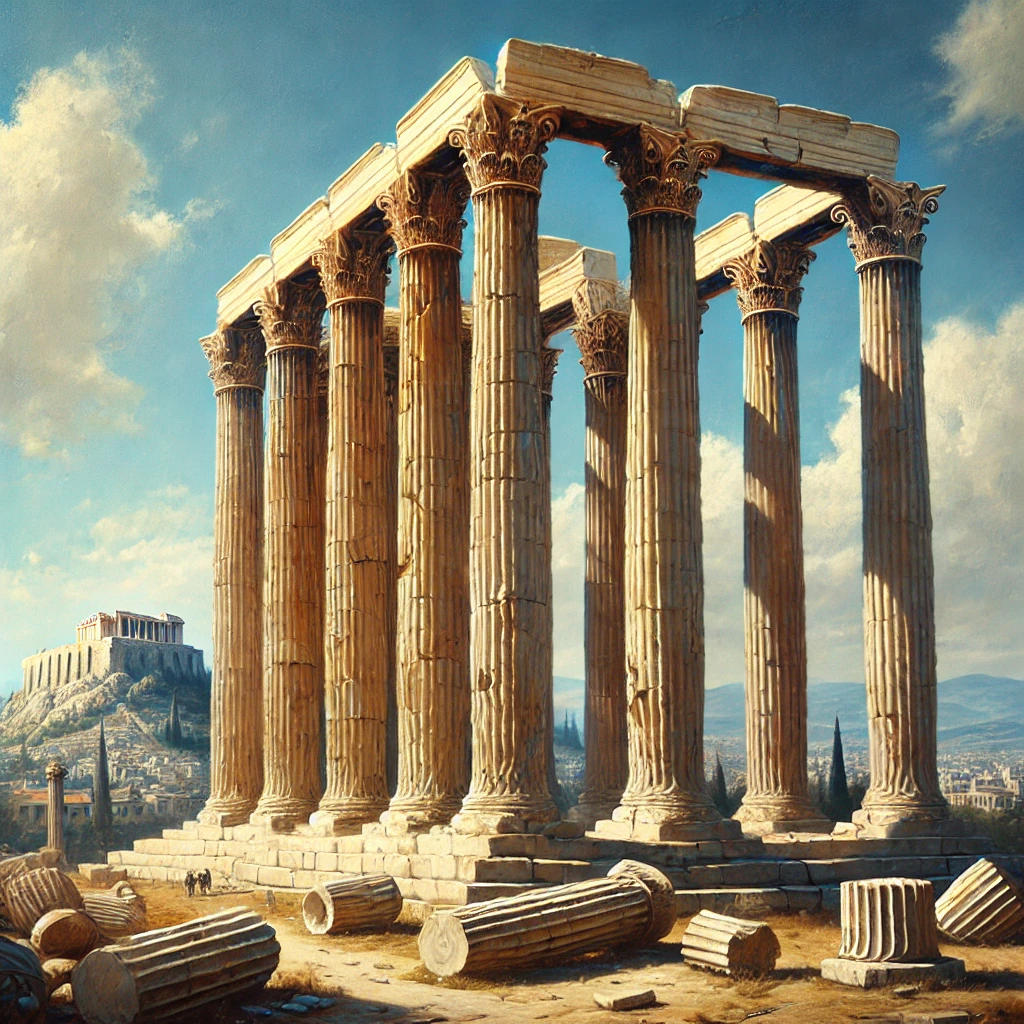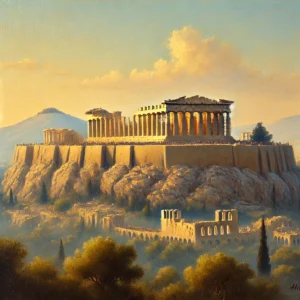In the heart of modern Athens, just a short walk from the Acropolis, lies one of the most awe-inspiring remnants of ancient Greece: the Temple of Olympian Zeus. Though only a fraction of the original structure remains today, the towering columns offer a glimpse into the grandeur of what was once the largest temple in Greece. Known as the Olympieion, this majestic ruin stands as a testament to Athens’ rich history, with stories that span centuries of political ambition, religious devotion, and architectural marvels.
A History Steeped in Myth and Power
The story of the Temple of Olympian Zeus begins in the 6th century BCE, during the reign of the tyrant Peisistratos. He envisioned a monumental temple to honor Zeus, the king of the gods, and symbolize Athens’ power. Construction began under his rule, but political upheaval and financial difficulties halted the project for several centuries.
It wasn’t until Emperor Hadrian came to power in the 2nd century CE that the temple was completed. Hadrian, a great admirer of Greek culture, oversaw the final stages of construction as part of his efforts to immortalize his reign in Athens. Upon completion, the temple boasted 104 massive Corinthian columns, each standing at 17 meters tall, making it a truly colossal structure dedicated to the chief deity of the Greek pantheon. Inside, it housed a massive statue of Zeus, likely rivaling the grandeur of other famous temples like the Parthenon.
Hadrian also placed a statue of himself inside the temple, alongside Zeus, further cementing his influence over the city. The temple became a symbol of imperial power and religious devotion, drawing visitors from across the empire. However, like many ancient structures, the Temple of Olympian Zeus eventually fell into decline. Earthquakes, invasions, and the passage of time took their toll, leaving behind the iconic ruins we see today.
Exploring the Ruins: What to See
Though only 15 of the original 104 columns remain standing, the ruins of the Temple of Olympian Zeus are still a sight to behold. As you approach the temple, the sheer scale of the columns is staggering. Their Corinthian capitals are intricately carved, and even in their ruined state, they evoke a sense of grandeur and majesty.
One of the most impressive aspects of visiting the site is the contrast between the ancient ruins and the bustling city of Athens that surrounds them. On one side, you have the modern skyline, and on the other, you can see the towering Acropolis, creating a powerful juxtaposition of past and present.
When visiting the Temple of Olympian Zeus, don’t miss:
- The Columns: Take a moment to stand beneath these towering remnants and imagine the scale of the original structure. Each column is made of Pentelic marble, the same material used to construct the Parthenon.
- The Fallen Column: In addition to the 15 standing columns, one column lies fallen on the ground, its segments scattered. This gives you a closer look at the impressive craftsmanship and size of the individual pieces.
- Hadrian’s Arch: Just a few meters from the temple stands Hadrian’s Arch, a triumphal monument built to celebrate the Roman emperor’s contributions to Athens. The arch also marks the symbolic boundary between the ancient city of Theseus and the Roman city of Hadrian.
The Significance of the Olympieion
The Temple of Olympian Zeus wasn’t just a massive architectural feat—it held deep religious and political significance. It was dedicated to Zeus Olympios, the ruler of the gods, and served as a place of worship for centuries. The size and scale of the temple reflected Athens’ desire to honor the most powerful of the Greek gods, while also showcasing the city’s wealth and influence.
However, it was also a political symbol. For Peisistratos, the temple was meant to solidify his power and link his rule to the glory of Zeus. For Hadrian, completing the temple was a way of leaving his mark on the city, blending Roman and Greek culture in a way that paid homage to Athens’ illustrious past while establishing Roman dominance.
A Temple That Outlived Empires
Over the centuries, the temple became a silent witness to the rise and fall of empires. After the Roman Empire declined, the temple fell into disrepair, its stones and materials scavenged for other projects. The statue of Zeus was lost to history, and natural disasters, such as earthquakes, contributed to the ruinous state we see today.
Despite this, the Temple of Olympian Zeus remains an important archaeological site and a symbol of Athens’ enduring legacy. Its surviving columns offer a glimpse into the city’s grand ambitions and its place at the center of the ancient world.
Visiting the Temple of Olympian Zeus: What You Need to Know
- Location: The Temple of Olympian Zeus is located just southeast of the Acropolis, making it easily accessible on foot from the city center. It’s a short walk from popular landmarks like Syntagma Square and the Arch of Hadrian.
- Hours and Admission: The site is open year-round, though hours vary depending on the season. It’s best to check local schedules before your visit. Tickets are affordable, and entrance is often included in multi-site passes that allow access to other ancient ruins in Athens.
- Best Time to Visit: To avoid the heat and crowds, it’s best to visit in the early morning or late afternoon. Visiting during these times also offers the chance to see the temple bathed in the soft golden light of sunrise or sunset, making for a truly magical experience.
- Bring Water and Sun
- screen: The temple is an outdoor site with little shade, so be sure to bring water and wear sunscreen, especially in the summer months.
A Majestic Reminder of Athens’ Glorious Past
The Temple of Olympian Zeus may not be as complete as it once was, but it still stands as a majestic reminder of Athens’ glorious past. Its towering columns and grand scale evoke the power of ancient gods and emperors, while its ruins offer a peaceful respite in the middle of a bustling city.
As you walk among the fallen stones and gaze up at the columns that remain, you’ll feel a connection to the countless people who have stood in this same spot, from ancient Athenians to Roman emperors to modern-day travelers. The temple is a place where history, mythology, and architecture come together, offering visitors a chance to step back in time and experience the grandeur of ancient Greece.
Explore Athens Further
Want to explore more of Athens’ ancient wonders? Check out our digital Athens city tour map, which offers curated walking routes, audio guides, and detailed insights into the city’s most important landmarks, including the Acropolis, the Roman Agora, and the Temple of Olympian Zeus. Unlock the secrets of the past and make your visit to Athens an unforgettable journey through history!








